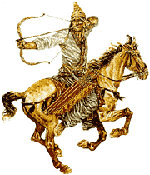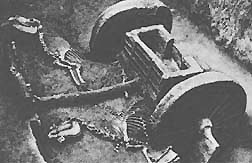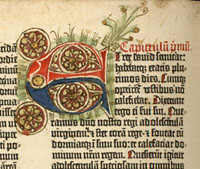Understanding History
Crossing BoundariesChange within a system can be fast or slow, and it can be advantageous to individuals either to join it or stand apart from it. Changes are rarely single; usually we find complexes of interrelated changes, making up a more general social development or political transformation. All this is intelligible on the usual linear model.
Other changes lack precedents in the system, and they often proceed at a different rate than changes growing out of the previous situation. It is in this group that we look for instances of ideas, or techniques, or strains of flu virus, introduced from outside. Such transplants, if successful at all, can be very successful, in an environment which happens to be receptive to them, but in which also they have no natural enemies, intellectual or bacteriological as the case may be. We may here consider some instances of introduced ideas, and one case in which the introduced ideas were greatly energized by crossing a cultural boundary.
Archery
In current orthodoxy, independent invention is the preferred, or the required, explanation of cultural parallels. This ruling overlooks the fact that it is very hard to have an idea. The Chinese drove chariot horses for more than a thousand years, during which time it occurred to no Chinese person to actually sit down on a horse. Cavalry warfare was not introduced until the year 0318, and even then, it was not a native discovery, but the emergency adoption of an all too successful technique of the steppe peoples, to the north of China. The story of the introduction of riding astride, which is probably nothing more than a story, makes plain the cultural resistance to the introduction (riding astride requires trousers rather than a robe, and the Chinese are highly committed to their own way of clothing). The event is logged into the chronology of the Shr Ji not as "adoption of riding astride" but as "adoption of barbarian clothing."
Said Briggs to Napier, of Napier's invention of logarithms, "but when by you found out, it is so easy." Everything is easy once somebody else has done it. Doing it without precedent is exceedingly difficult. The long failure of an individual, or an entire culture, to make what to us seems like an obvious observation, or an evident improvement, should go far to disable the idea that ideas are easy to have, and can be lightly posited as occurring spontaneously, as part of the order of nature.
The Chariot
So much for riding horses, which is not likely to be a Chinese local inspiration. Wwhat about the earlier Chinese practice of driving horses? This case turns out to be remarkably similar. The Shang war chariot is recognizably the Mesopotamian war chariot, and after fifty years of stalwart and sometimes acrimonious denial, this manifest fact has recently been conceded in orthodox Sinology. Not only is the similarity strong, but there no period of previous development within China, whereas the cart to chariot progression is clear in West Asia. The word for "horse" in every East Asian language, Chinese ma, Okinawan mma, Japanese uma, is Indo-European (to Burmese mrang "horse" compare Old High German marah "horse." What we have here, around the year 01200, is not an imported item, but an intrusive culture complex. Whether it came in at once, with a group of intruding Indo-Europeans, or by gradual stimulus diffusion, as some evidence suggests may be more likely, its impetus was external.
The culture complex in question included the concept of writing (this is one argument for diffusion rather than importation), and the use of bronze. The historical result was the dominance of the people in the area where the new ideas were most concentrated: the small-domain Shang.
The pattern here is obvious. To recognize introductions, historians need to become familiar with the typology of introduction in general. Among the characteristic indicators are:
- Introduced words relate better to the home language; they have more connections and more cognates; exotica are more isolated. See our page on loan translations from Sanskrit into Chinese.
- Introduced techniques tend to lack preliminary stages, and to appear at a sophisticated state of advancement. The Shang war chariot (derived from Mesopotamia) is one obvious example.
- Introduced or externally inspired techniques may flourish briefly in their new setting, but then die out because the conditions for sustaining them are absent. Mician logic; the cargo cult.
The implication of these examples is that even China, despite its isolated position on the fringe of Eurasia, was available to external influence and input, in the early bronze age and also in the late pre-Imperial age, from Mesopotamia, India, and Greece, the latter influence being probably mediated by the Alexandrian conquest and Hellenization of the chief Eurasian transshipment point, Bactria. This being established, it cannot be denied that China owes something to the outside world. Even if the mechanism of transmission is not precisely known in any of these instances, the fact of transmission is manifest. Transmission thus enters the list of possible explanations for individual facets of early Chinese culture.
And for facets of culture in general.
The Print Complex
Many introductions, like the plants which are a zone too far south for your garden, tend to die out. But those which do not die out can be very successful. Malaria may disable newcomers, whereas the natives have developed immunity. Contrariwise, a plant (purple loosestrife; the kudzu vine) may run wild if introduced into an ecology where it has no natural enemies. So also, an idea moved across a cultural boundary may be freed of previous inhibiting factors, or find more a climate more favorable to its development.
Printing from movable types, a Korean modification of an earlier Chinese invention, did not have significant results in its isolated home country, but led to an explosion of learning and literacy when introduced into the European multi-state system. And have you tried printing on parchment or papyrus? Paper was a Chinese invention, introduced to Europe by way of the Arabs. Gunpowder was used in China for centuries without revolutionizing warfare in China. In Europe, it led to a social and technical upheaval in how wars were fought. The compass and the sternpost rudder, two conditions of practical open-sea navigation, were developed in China, and Chinese voyages were made as far as the east coast of Africa, but the whole development was narrowly based on one court faction, a eunuch faction at that, and it presently fizzled. In Chinese context, the commercial advantages were helpless against the cultural disdain. In European context, with the search for wealth sponsored by competing governments rather than resisted by factions within a single government, these things led to an age of exploration and to the domination of Asia by Europe. The equal tempered scale was invented by a Ming prince, but it had no influence on subsequent Chinese music. Transmitted to Europe via Russia, and there popularized by the circle centering around Mersenne, where it could affect the theoretical nerve center of European culture, it created a watershed in music, drawing a line between mediaeval and modern, and making possible the harpsichord pieces of J S Bach. The Chinese science of government inspired Machiavelli, and Chinese theories of economics (in a typically Chinese agrarian form) underlay the thought of the Physiocrats, the first Europeans to devote intellectual attention to what was going on in this part of the human sphere. The Physiocrat beginning quickly mutated into our present science of economics, while China remained content with earlier concepts. The European Renaissance was largely built on imported ideas; ideas which were dead ends at home, but hugely successful abroad.
One looks in vain in the standard European history textbook for any recognition of these facts. As far as the standard European history textbook is concerned, Europe is self-created. This may be logged in as merely one more example of the principle noticed above: the standard tendency for cultures to assert an autochthonous past; a self-identical history.
Readings
- Leon Trotsky. History of the Russian Revolution. 1930; tr 1932
- Edward L Shaughnessy. Historical Perspectives on the Introduction of the Chariot into China. HJAS v48 #1 (1988) 189-237, especially 208
- Robert Drews. The End of the Bronze Age. 000, especially 000-000
- E Bruce Brooks. Alexandrian Echoes in Chinese Texts. Reopens a question dismissed by Needham, with a more accurate chronology of the source texts, and finds Greek influence likely, not indeed from Greece, but from Hellenized Bactria after 0327. This conquest put Greek city culture within the range of the early Chinese silk traders, for whom, as Herodotus records, Bactria was the transshipment point.
- A C Graham. Later Mohist Logic: Science. Singapore. The resemblances to Greek optics are set forth in some detail. Like the examples discussed in the previous work, the Mician logical and technical writings all fall after the Alexander date of 0327.
- Joseph Needham. Science and Civilisation in China. Needham bought heavily into the Chinese chauvinism of his day, and denies all external influences on early China. He meticulously, and convincingly, documents later East > West influences. For equal temperament, see v4A 214f.
17 Mar 2006 / Contact The Project / Exit to Outline Index Page



